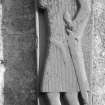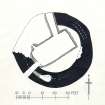Following the launch of trove.scot in February 2025 we are now planning the retiral of some of our webservices. Canmore will be switched off on 24th June 2025. Information about the closure can be found on the HES website: Retiral of HES web services | Historic Environment Scotland
RCAHMS Inventory: Outer Hebrides, Skye and the Small Isles.
Date 1914 - 1928
Event ID 999452
Category Project
Type Project
Permalink http://canmore.org.uk/event/999452
Individual descriptive articles from the ‘Inventory of Monuments and Constructions in the Outer Hebrides, Skye and the Small Isles’, published by RCAHMS in 1928, were entered into Canmore between September and November 2020. Where the articles exceeded c.1,500 words in length, only the introductory paragraphs were reproduced.
Readers may consult the original text to clarify details and to access the related material in the introduction and glossary etc. It can be downloaded as a pdf as Digital File WP 003958 (https://canmore.org.uk/collection/1471347).
For contemporary reviews of the publication, see C Fox, Antiquaries Journal (8), 1928, pp.536-8, and M Wheeler, Antiquity (3), 1929, pp.379-81.
The ninth report of the Commission, included in the front matter of the original publication (RCAHMS 1928, v-vi) is reproduced here as it provides a measure of the staffing, context and scope of the survey, the fieldwork for which extended over some 11 years:
"We, Your Majesty's Commissioners, appointed to make an Inventory of the Ancient and Historical Monuments and Constructions connected with or illustrative of the contemporary culture, civilisation and conditions of life of the people in Scotland from the earliest times to the year 1707, and to specify those which seem most worthy of preservation, humbly present to Your Majesty this our Ninth Report.
Appended to the Report is a list of the monuments and constructions in the Outer Hebrides, Skye and the Small Isles, which, in the opinion of Your Commissioners, seem most worthy of preservation and in need of protection. In the case of this district we have found it inexpedient to follow our usual practice of dividing the list into two groups.
Your Commissioners have to express their thanks for the courtesy and cooperation which they have experienced at the hands of the owners of historical monuments in the Islands, and particularly for special services rendered by the Earl of Dunmore, the Countess Vincent Baillet de Latour, Major Kemble of Knock, Skye, the late Erskine Beveridge, LL.D., C. G. Mackenzie, Esq., Procurator-Fiscal, Stornoway, the Rev. Malcolm Macleod, formerly resident at Broadford, Skye, and G. M. Fraser, Esq., bank agent, Portree. In addition they have to thank the Society of Antiquaries of Scotland and the representatives of the late Erskine Beveridge, LL.D., for the use of certain blocks as illustrations.
The actual work of the survey, owing to special circumstances, has extended over an unusual length of time. It was begun in 1914, the year in which the War broke out, and was continued in the summer following, but was suspended in 1916 and remained in abeyance for four years. During 1921 and the following years work had necessarily to be much restricted so that only small sections could be done from time to time, and not till the summer of 1925 had the whole of the ground been covered.
The broken and difficult character of the area under investigation added another handicap. Travelling was subject to delays of various kinds. Weather, too, in these regions is at once an influential and an unstable factor. The fact that so many ancient monuments exist on islets in lochs also imposed peculiar limitations. In some cases a partially submerged causeway could be used, though only at the cost of a wetting; very rarely a boat was available; more often the remains were inaccessible without special provision, and observations consequently had to be made from the shore.
In the islands archaic structures of all kinds, while very numerous, are for the most part in a seriously dilapidated condition. Even where present-day remoteness has preserved them from human interference, time and tempest have been effective destroyers. Certain erections, however, still rank among the best preserved of their class: an undisturbed 'long cairn' in Skye, near Kilmarie, Strathaird [Canmore ID 11434], the standing stones of Callanish [NB23SW 1], the broch of Carloway [NB14SE 1], the church of St Clement at Rodil [NG08SW 7]. It is satisfactory to note that the last three of these monuments are now under the care of Your Majesty's Commissioners of Works. There are others, such as remains of brochs, a type of structure peculiar to Scotland, which well deserve special consideration and the fuller exposure, at the hands of an expert archaeologist, of such features as survive.
There is evidence that private parties landing from yachts have not scrupled to interfere with ancient monuments and even to remove such as were portable. In one case at least the proprietor of an island found it necessary to take action. Your Commissioners hope that the publicity now given to such activities may lead to their cessation.
Almost all the prehistoric structures recorded in the Inventory were visited and described by Mr J. Graham Callander, now Director of the National Museum of Antiquities, and Your Commissioners in this connection would take the opportunity of expressing their appreciation of Mr Callander's skill, care and unflagging energy in carrying through this part of the work.
For their knowledge of the remains upon St Kilda Your Commissioners are indebted to the kindness of Captain Patrick Grant, late of the Indian Army, who happened to be visiting the island. The report on structures in the Flannain Isles is based on information and photographs supplied by Mr Cadger, District Superintendent of Lighthouses, through the friendly co-operation of Mr. J. Dick Peddie, Secretary to the Northern Lighthouse Board. The visit of our staff to the remote island of North Rona was arranged by the Fishery Board through Mr Jones, Chairman of the Board. Here and at the Flannain Isles a landing cannot be guaranteed even in comparatively fine weather. The conditions happened to be favourable for a brief visit to Rona, but the neighbouring island of Sula Skeir had to be omitted.
As to the spelling of names in the islands, Your Commissioners have adhered, for obvious reasons, to the practice of accepting the forms on the maps of the Ordnance Survey on the scale of six inches to a mile.
Since the issue of our last Report, the long vacant post of Archaeologist on the staff has been filled by the appointment of Mr J. M. Corrie. More rapid progress is thus ensured in the collection of material. Your Commissioners welcome the appointment of Viscount Novar, K.T., G.C.M.G., and Mr James Curle, LL.D., to fill vacancies in their number.
HERBERT MAXWELL, Chairman. ALEXR. O. CURLE. G. BALDWIN BROWN. GEO. MACDONALD. THOMAS H. BRYCE. NOVAR. THOMAS ROSS. JAMES CURLE. W. MACKAY MACKENZIE, Secretary.
Edinburgh, 12th July 1927."













































































































































































































